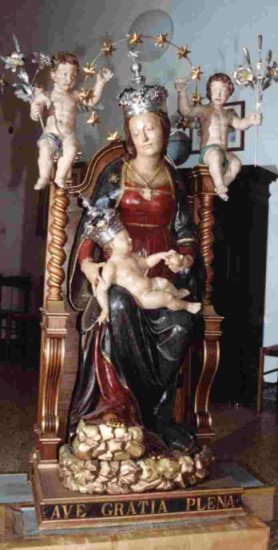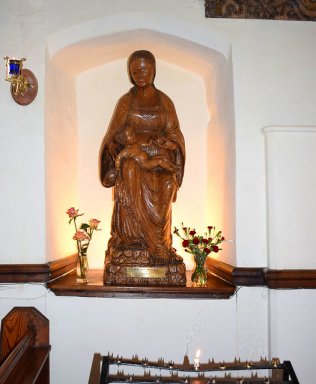So now the big
question – do the miracles really happen? If so, how? And if not, why
were people convinced? What was going on? We need to bear in mind that,
like saintly relics, some people are still certain that they do work.
The Dorset church of Whitchurch Canonicorum has the shrine of St Wite
that somehow survived the reformation. On our visit the shrine was full
of notes pleading for intercession by the saint. There were also notes
thanking her for what she had done.
The suggestion that paintings were produced by saints such as
Luke, is impossible to prove, and dating evidence does not support it.
Images said to speak, or move, are very much in the category of
‘according to legend’. But what of images said to provide cures?
The cynical view is that spreading tales of such miracles is
entirely fraudulent, perpetrated by institutions with an eye to
money-making opportunities. There is no doubt that the possession of
miracle-working relics and images did bring in money, and there are a
number of historical instances where fraud has been proved. But the
question arises – if no miraculous cures ever happened, wouldn’t
pilgrims become aware of this as time went by? Well, possibly not –
social media did not exist then to deny fake news. Nevertheless, the
record of cures is overwhelming. So, if miraculous images did work, how
did they?
One option is: it’s all true. The sacred images provide
links to the person portrayed – in most cases, Jesus and the Virgin Mary
– and intercession may be provided. If this goes too far for most people
these days, the church speaks of faith – and what it can do for
believers. This leads on to something much debated these days - the
placebo effect. Can a powerful belief in the efficacy of a cure – be it
a sacred relic, or image, or placebo tablet – actually make it work?
Evidence suggests that it can:
in which case, then genuineness of the treasured item wouldn’t matter.
Research continues.
One thing is for sure: many of the locations of sacred images
and relics have a powerful atmosphere, sensed by many as they enter the
building. What can this be?
A much debated theory on this is known as Morphic Resonance, an
idea written about at length by the scientist Rupert Sheldrake. He
suggests that the consciousness of visitors, especially at special,
sacred places, accumulates over the centuries, and can be sensed and
reacted too. Maybe this collective consciousness could create the
placebo effect in those whose faith was strong enough. Going beyond
this, it has been suggested by some that objects – sacred relics, sacred
images – can absorb that consciousness, which gives them their special
power.
In a brief email conversation with Rupert Sheldrake, I posed the
question: can sacred images and relics cure people who believe they can?
His reply: I do not know the answer.


Our Lady of Ipswich
The statue of the Virgin and Child on the left above can be seen in a church in Nettuno, Italy. It is sometimes referred to as ‘the English Lady’. Now why is that?
Before the reformation there were many shrines to the Virgin Mary in England. East Anglia had many, and one survives today, at Walsingham. A very important shrine was in the town of Ipswich; Our Lady of Ipswich was an important pilgrimage destination, and there are many stories about the efficacy of the cures achieved there. Thomas More records the curing of a twelve-year old girl who suffered from severe seizures. When she was taken to the shrine, in front of many people she was cured ‘perfytely and sodeynly’.
On September 28th, 1538, the shrine was destroyed, and, it was claimed, the statue of the Virgin was taken to London and destroyed. But was it? Increasing evidence suggests that it was somehow rescued, and ended up at Nettuno. Had a genuine miracle occurred?
The Reformation is now in the past. The statue shown above left is a replica of the one at Nettuno, installed in a church in Ipswich near to the site of the original shrine in 2002. Present were an Anglican bishop, a Catholic dean, and representatives of the Eastern Orthodox and Methodist churches.